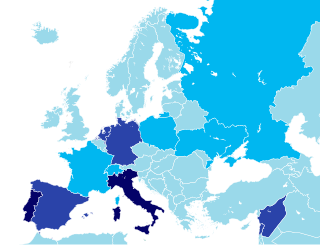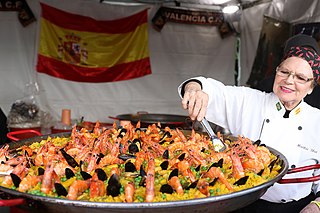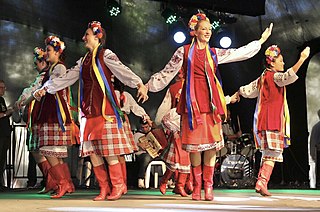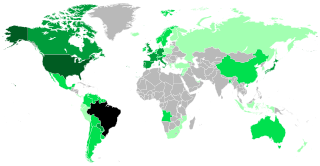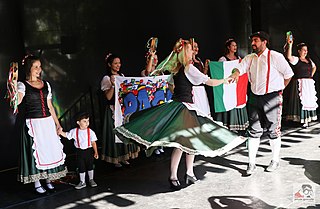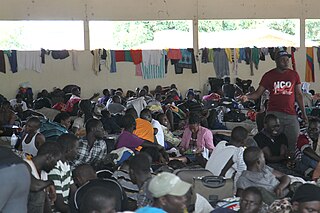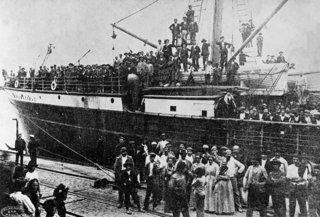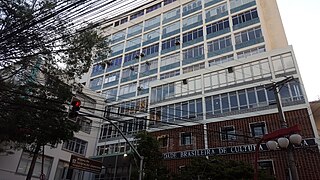Spanish emigration peaked in the late 19th and early 20th centuries, and it was concentrated to Argentina, Uruguay and Cuba. Between 1882 and 1930, 3,297,312 Spaniards emigrated, of whom 1,594,622 went to Argentina and 1,118,960 went to Cuba. [1] Brazil only started to be an important destination for immigrants from Spain in the 1880s, but the country received the third largest number of Spanish emigrants, behind only the two aforementioned countries. Spaniards also made up the third largest national group to immigrate to Brazil, after the Italians and Portuguese. [1]
Contents
- Origins and destinations
- Numbers of immigrants
- Brazilians of Spanish descent
- Education
- See also
- References
Between 1840 and 1849, only 10 Spaniards immigrated to Brazil; 180 did so between 1850 and 1859; 633 between 1860 and 1869; and 3,940 between 1870 and 1879. The number of arrivals increased significantly between 1880 and 1889, when 29,166 Spaniards arrived. [1] Spanish immigration to Brazil was a direct result of the efforts of the Brazilian government to attract European workers to the country, in order to “whiten” the Brazilian population and to replace the African manpower. [1] The Brazilian government spent large amounts of money paying passages of European immigrants by ship (subsidized immigration). A huge propaganda was conducted by the Brazilian government in Spain, with agents that worked for it (ganchos) who went to the country in order to persuade Spaniards to immigrate to Brazil. [1] The Brazilian government offered the free travel by ship to Brazil, and that was decisive in attracting immigrants. Brazil was a country far less attractive than Argentina and Cuba, countries with which the Spaniards maintained cultural relations. Moreover, the working conditions in Brazil were much worse. Thus, the Spaniards who emigrated to Brazil were those who could not afford to pay a passage by ship to Cuba and Argentina, the poorest ones, and took advantage of the offer of free travel to Brazil. For the wretched Spanish peasants, the free passage by ship offered by the Brazilian government seemed a great opportunity to leave poverty. [1]
The Spanish community was present in all São Paulo. [1] According to a 1933 research, the largest concentration of Spaniards was found in the region of Catanduva, Rio Preto, Araraquara, Santa Adélia etc., with 108,000 Spaniards. Next was the central part of the state in cities such as Campinas, Sorocaba, Itu and Jundiaí, with 28,000. Northwest São Paulo, in cities such as Bauru, Araçatuba and Marília had 45,000 Spaniards. This way, about 75% of the Spanish community in São Paulo was concentrated in the region of Araraquara and in the Northwest and in those areas the towns with most Spaniards were Tanabi, Mirassol, Nova Granada (named after the Spanish city of Granada), São José do Rio Preto and Olímpia. The city of São Paulo had 50,000 Spaniards. The 1913 census in Santos found a population of 8,343 Spaniards out of a population of 39,802 people. In 1931 there were 11,982 Spaniards in that city, out of a population of 125,941 people (or 9.51% of the total population). [1]
Reports that Spanish immigrants were living in appalling conditions in Brazil made Spain, in 1909, sent to Brazil the Inspector Gamboa Navarro in order to assess the situation of the Spaniards in the country. [1] Navarro made a report, which showed that employment contracts were "illusory", because they were not respected. In coffee plantations, he wrote that the immigrants slept on the floor and in tiny houses and also reported that the abuses in labour relations were frequent. He concluded that 98% of the Spaniards in Brazil would return to Spain if they could. Three weeks after the publication of that report, Spanish newspaper Gaceta de Madrid proposed a ban on Spanish emigration to Brazil. The newspapers remembered that Italy and Germany had already passed laws on the subject and that Portugal was trying to conduct its immigrants to other countries rather than Brazil. Finally, on August 26, 1910, Spain issued a royal decree prohibiting the free emigration to Brazil. The decree did not have any effect and, curiously, the Spanish immigration to Brazil peaked after it was issued. [1]
Other reports suggest that there was a thriving Spanish community in Brazil, particularly those who were able to leave the coffee plantations and to buy their own lands. [1]
It is estimated that since Brazil's independence (1822) some 750,000 Spaniards have entered Brazil. This figure represents between 12.5% and 14% of all foreigners entering Brazil since its independence and puts the Spaniards in the third place among immigrants in Brazil, behind the Portuguese and Italians. Immigrants of Spanish origin were among those who had a higher rate of permanent residence in Brazil, overtaken by the Japanese but above nationalities such as Portuguese, Italian or German. This may be due to the large number of families traveling with passage paid by the Brazilian government that left their native Spain to work on coffee plantations of the state of São Paulo. Most Spaniards entered Brazil between 1880 and 1930, with the peak period between 1905 and 1919, when they overcome the entry of Italians. [2]

